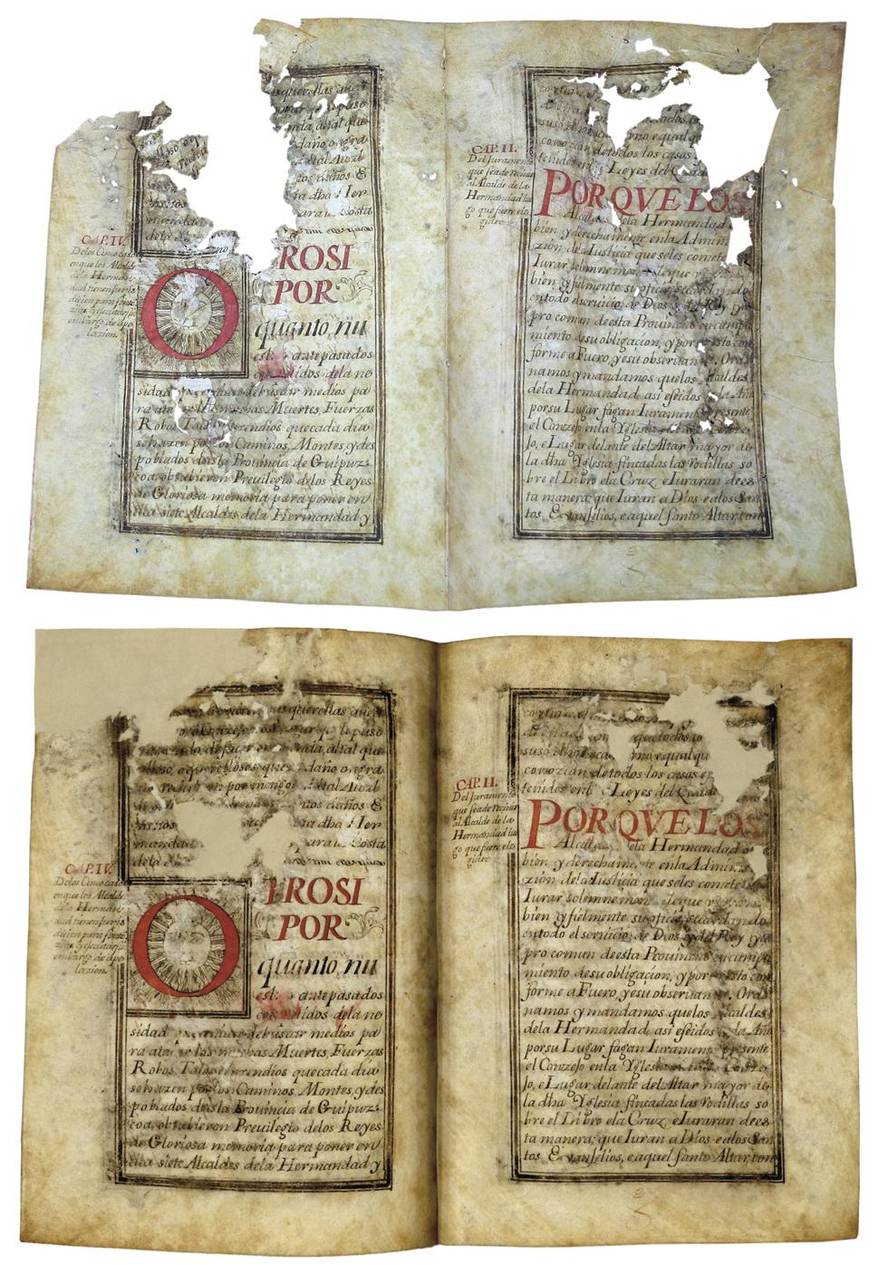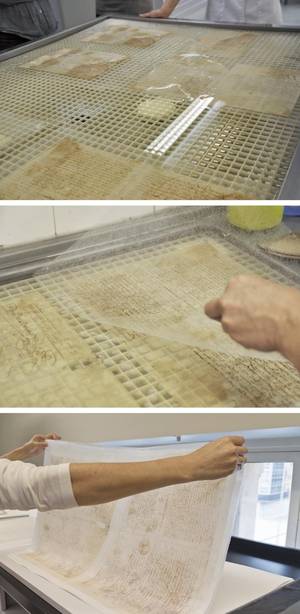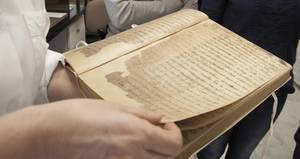New old papers

Gipuzkoa General Archive is located in Toulouse. XV. It includes documents from the 20th century. The building itself has been the depositary of these documents since 1904. However, before there, they were in the church of Santa María de Tolosa, on the sacristies, from 1530. The conditions were not the best to keep the documents without deteriorating them. Moreover, they were affected by fires such as the XVIII. At the end of the 20th century, as well as wet, in the aforementioned fire, the neighbors deposited several documents on the bank of the Oria River to protect themselves from the flames.
Documents affected by these incidents need to go through the restoration laboratory. They are cured in the laboratory so that they continue to fulfill their function, that is, so that all interested people can consult them.
In 1991 the restoration laboratory was launched with the last renewal of the General Archive, and when setting the Priorities, "it was chosen to start with the oldest documents. In addition to the historical value of being farther in time, there is less chance that there will be copies," explains Esther Escalante, archivist of the Gipuzkoa General Archive. "We are restoring the fund of the Boards and Councils of Gipuzkoa, which is our main fund. In addition, we work with books from the University of Oñati and Koldo Mitxelena. Likewise, if an entity asks us for documentation for exhibitions, for example, we resolve them if necessary. And it is that anyone can consult the works stored here, for being conducting an investigation or for wanting to go back in the history of his family".
In addition to the restoration, it is very important to keep the documents in suitable environmental conditions, "The temperature is kept at 18-20ºC and humidity at 55-65% and we have placed sheets on the windows to prevent sunlight from entering," explains Escalante. In fact, "water and air cause oxidation in the components of the paper, and sunlight also greatly impairs the paper," explained Inés Berasategi, professor and analyst at the Tolosa Paper School for 30 years. This oxidation makes the paper increasingly acidic and in that acidity hydrolysis or cellulose rupture occurs."
Ultimately, cellulose is the most important component of paper. It is a chain of interconnected glucose molecules, and "the more units the chains are, the stronger the role," added Berasstrategy. However, over the years, the hydrolysis reactions of the cellulosic chains are easier and more frequent, and the paper loses resistance, as acidity accelerates the process." The paper loses flexibility, becomes yellow and breaks when passing the pages. In the end you cannot even open old books.
"XIX. The role of the documents until the 20th century is of very good quality, Berasstrategy continued, with linen, cotton and plants of quite pure cellulose until then. XIX. However, wood was used in the 20th century. Paper production increased, but paper durability and therefore aging deteriorated greatly." In fact, in wood, a quarter is lignin, and "causes processes such as oxidation or amarility."
In addition, in the nineteenth century began to use a tail called rosin. In the 20th century. Rosin is a resin of conifers. "This glue adheres very well to the fibers and does not flow with water," says Berasstrategy. But it needs an acidic pH, which remains on paper."

Return of functionality
Restaurateurs work with documents with great respect. "Every intervention we make must be reversible. That is, it must be possible, if you want, to return the document to its original state", explained Eli Bereziartua, worker of the restoration laboratory.
Before starting work, they perform a detailed analysis and description of the document. "We make the diagnosis sheet by sheet." A thorough analysis of the ink used to describe and write down the impact of the paper is performed, in order to know exactly what they can do and what they can't.
They often find holes caused by bibliophagos. There are about a hundred species of bibliophagos, including insects called silver fish, as well as mice. They feed on carbohydrates and as they are eaten create galleries in documents. The documents also contain fungi and bacteria.
Escalante explains that they also have problems with the inks used to write documents: "If they preferred to use metal-acid inks to write. In fact, by containing a metal and an acid, with the passage of time it is transformed into sulfuric acid, reaching to perforate the paper and to transform the paper into coal. Before reaching this point, in addition, the ink expands and what is written is not read."
Particularly difficult was the repair of a 1704 book that includes, among other things, the ratification of the Gipuzkoan forces by Philip V. Bereziartua recalled that one of his greatest difficulties was that the pages were stuck together in some parts of the book: "Somehow, the authors wanted to separate themselves from the rest of the pages and made it beautiful, giving them beeswax and karnauba as tight. With the passage of time the waxes of some leaves merge with those of the adjacent leaves, remaining all attached".
The restoration could be addressed by removing this varnish with the right compounds. Like all the documents, the first step was cleaning the hygienization chambers and disrupting any biological activity. The elimination of insects and microorganisms is carried out through its introduction into alcohols "provided that it does not harm fibers or ink, hence the importance of previous analyses. With them we will know what organic solvents we use and whether it is better to replace alcohol with acetone, or for example trichlorine," explains Bereziartua.

Innovative bathrooms
Then comes the aquatic phase. "We partially clean with water the fiber that has not been cleaned with organic solvents. We have a role in water in 10-20 minutes. In addition to cleaning, water strengthens hydrogen bridges that act as magnets between fibers," explained Bereziartua.
Likewise, Bereziartua stressed that "if the pH of the document is less than 6.5, we give it an alkaline reserve. That is, we introduce it in a calcium hydroxide bath. In this way, we neutralize the acid reactions that cause the deterioration of the paper and protect it against the acidification that the document will suffer in the coming years, since calcium is included among the fibers".
In the bathroom to increase the alkaline reserve, if necessary add a thin sheet of paper (lamination). "This fine paper has only 3 grams per square meter and gives body to the document."
Finally they complete the documents by filling the missing parts with the new paper fibers. "We try that the fiber we add, cotton and linen, has the same color as the paper. If the paper is yellowish over time, we also dye yellow the fiber we introduce. We do not bleach because for this we should use hypochlorites that damage and weaken the fibers".
The goal of the filling, according to Bereziartua, is that "the document is manageable, since we return its original appearance and size and breaks the process of rupture. That is, we stop deterioration or degradation."
They have a filling machine. It is a suction pump that mixes the fibre paste into the water with the document placed at the bottom of the machine and pour it. By starting the pump, the water leaves the tank by the less resistant areas, that is, by the holes of the document. With water extraction, the mixed fiber is deposited in the holes.

Once the paper of the rebuilder has been extracted, the starch squeeze (vegetable glue) is given to the document to glue the fibres together, leaving only the drying. "We surrounded them with drying papers and placed them between wooden boards, since we have seen that it is the best way to maintain the original structure of the fibers. Then, we recompose the book or document," says Bereziartua. That is, they fold the sheets, mount them and return the original aspect of the document. "A totally fragile and weak document is once again manageable," says Escalante.
To make it manageable and durable yes, but the goal of restoration is not, "at all, to rewrite what was written in an original document, even if we know what it put in the origin, it would be to manipulate it," says Bereziartua.
The interventions that are made in relation to ink are, on the one hand, to protect with fixators to prevent the entry of paper in the washing water, in cases where there are soluble inks, destroy the expanded ink and re-read the written.
Following process improvements
All interventions are carried out following the regulations established for the restoration of the paper. These standards, however, change and respond to the advice of researchers working on improving restoration processes around the world: "They showed, for example, that a certain ink fixator causes the paper to become yellow over time and ordered not to be used," explains Bereziartua.
Singularizado has determined that they do not enter any hand, following the criteria of the file, "if we suspect that any of the components of the document will be damaged or that we will not be able to recover its original appearance or characteristics. We cannot prevent information, writing or characteristics of the documents. If we don't guarantee it, it means we haven't worked well." In case of any of these cases, they adopt basic preventive measures in the archive: they insert neutral pH papers in the document (so that the acidity does not continue to lose), take care of the environmental conditions and collect the information contained through photographs and digitization. "Nothing else, until they invent measures to treat them."





